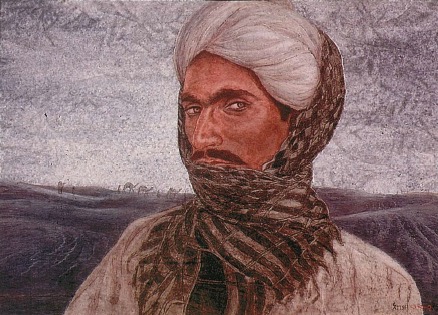By LAVINA MELWANI, NEW YORK
You can call it his brush with death. Three years ago, noted Delhi artist Satish Gupta discovered he had a brain tumor. The chances of survival were fifty-fifty. He recalls, “Before the surgery, I was almost suicidal. I had no will to live.” The tumor was removed successfully, and his surgeon told him, “It’s really a rebirth. Don’t waste this life.”
Three years have passed, and Gupta has remembered those words every day, almost like a prayer. He affirms, “Now I feel each day is so precious. We waste so much time, so much energy over trivial things, but life is so grand. When you come so close to losing it, life becomes very, very special.”
Gupta’s close encounter with death has impacted his work. He observes, “It gives you a deeper understanding, a deeper perspective. I can empathize much more with people. I can almost get into their soul and paint them.” The artist is the son of the late freedom fighter Deshbandu Gupta, and as a child was profoundly influenced by the untimely death of his father in a plane crash. He withdrew into his own world, creating a perfect world with paints and paper. After attending Delhi’s College of Art, he earned a scholarship to Paris at the Ecole des Beaux Arts.
Visitors to Delhi may encounter Gupta’s work as soon as they step onto Indian soil. A massive 260-foot-long mural of Indian life by him graces the arrival lounge. Rebirth seems to have inspired him to create as much beauty as he can. Besides his desert and seascapes, he is working on sculpture. Currently he’s doing a significant piece for an atrium in a corporate building in Delhi. The 24-foot-high sculpture depicts the deities of the five elements–Agni, Prithivi, Vayu, Vishnu and Brahma–in five columns, each made of a different metal and weighing several tons. For the past two years, he’s also been working on a series called Poems to the Sea, painting as many oceans and seas of the world as he can. He takes 30-foot-long scrolls, paints on them with water-proof inks, sometimes writes a poem on them and submerges them into the water. He’s done this in the Mediterranean, Pacific, Atlantic, North Sea, English Channel and the Caribbean Sea. Once immersed, the work gets worked over by the waves and water, but that’s part of the process. Later the art is dried, and the impressions of the water world remain.
Gupta is a Hindu but is open to all faiths. He says, “I think religion can be very beautiful, and it can be very ugly, too. Unfortunately, the ugly part of religion–the communalism and orthodoxy–takes over, and it can be used by a handful of people to really control the masses. It can be a power thing. But if you go deeper into it, it can be so nourishing.” He adds, “What’s beautiful about Hinduism is that it’s all-embracing. When I painted the priest at Pushkar, there were Muslims coming in and praying. They were fed like all the other worshipers.”
Gupta’s first night in Pushkar was unforgettable. He recalls, “It was a dark night and the hills were silhouetted against the moon. There was this white temple which was bluish-indigo in the moonlight. The antique door was open and through it I saw the priest playing his harmonium at midnight. There was no one else there, and he was singing bhajans all by himself. I stood there, outside in the dark, for about 45 minutes, listening to him. He wasn’t aware of me at all. I was so taken up with the idea that this man would just sing to the Gods, not for an audience, not for anything. I’ve painted him twice, and it was a wonderful experience.”
“WE ARE ALWAYS LIVING AT HIS FEET. WHOM SHALL WE WORSHIP OTHER THAN HIM? AND WE HAVE EVERY RIGHT TO WORSHIP HIM. HE IS OUR “LIFE OF LIFE AND THE EYE OF THE EYE.”
KENA UPANISHAD 1.2
